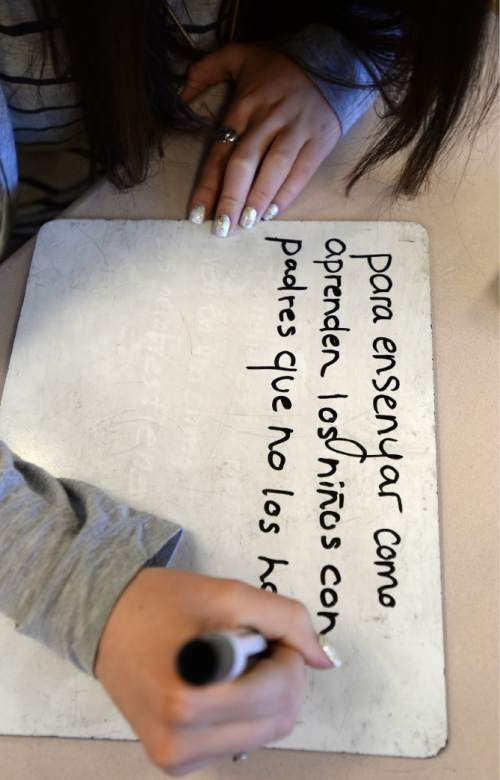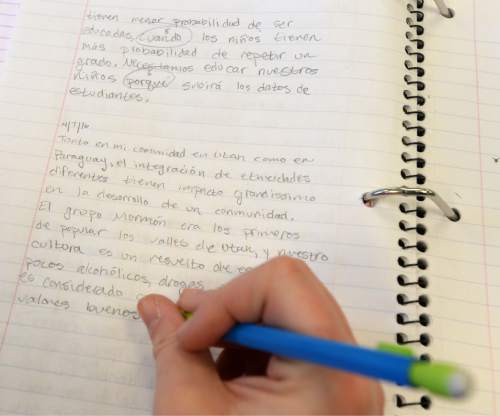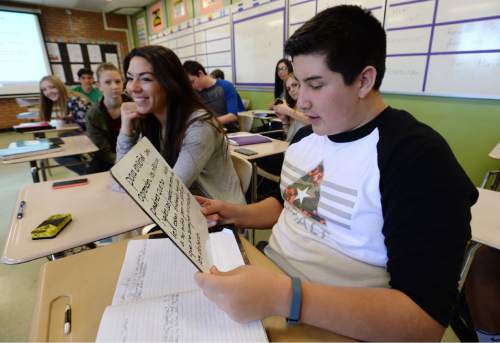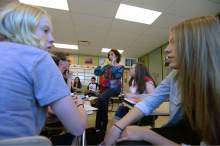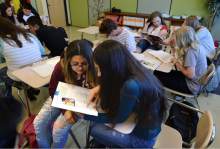This is an archived article that was published on sltrib.com in 2016, and information in the article may be outdated. It is provided only for personal research purposes and may not be reprinted.
Layton • Layton High School sophomore Mikelle Argyle doesn't consider herself fluent in Spanish, but she feels confident about taking the AP Spanish test this week.
That's because Argyle — a native English speaker — has spent a portion of every school day speaking Spanish since she was in first grade.
Argyle and her classmates, plus a similar group of sophomores at Viewmont High, were the first students enrolled in a pilot program, now in 138 schools statewide, where elementary students spend half their days learning math, science and other subjects in an immersion, or non-native, language.
"Pretty soon we were getting better and better," Argyle said of the group's Spanish skills. "We were almost on the same level as our teachers at a certain point."
Since 2006, Utah's dual-immersion program has dropped elementary children into an environment where, from Day 1, they're expected to complete their reading, writing and arithmetic in a foreign tongue.
The program followed students into junior high in 2012 with the creation of immersion courses in social studies, health and humanities, which supplemented pre-existing language electives to allow for part-time immersion beyond elementary school.
The result is a fast-track to Advanced Placement language courses, which are traditionally taken by high school juniors and seniors, and allow students to earn lower-division college credit by passing an AP exam.
"In first grade it was the most difficult, but after that, it just seemed normal," said Layton High sophomore Jordan Brown. "The hardest part, actually, was trying to learn the stuff back again in English."
And with years to go before the immersion students graduate from high school, the program is launching a final step that will connect students with university-level language education.
Beginning this fall, students who pass an AP language course and exam will have the option to enroll in a suite of three concurrent enrollment courses that, in a first for Utah, will award upper-division university credit to high school students.
"When they graduate from any Utah high school, they're only two classes short of having a minor in that target language," said Gregg Roberts, world language specialist for the Utah Office of Education.
The latest change marks the culmination of a comprehensive, K-12 language immersion program, the first of its kind in the country and more than a decade in the making for Utah.
And for some students on the front line of the program, like Layton sophomore Lauren Forsgren, the decision to put 12 years of Spanish skills toward a college minor is a no-brainer.
"If I'm two classes short, I'm going to take those two classes and get [the minor]," she said. "That's easy, that's fast, and it's going to be useful to me."
—
Modern literacy • The walls of the Layton High classroom where Argyle, Brown, Forsgren and their immersion classmates are prepping for the AP exam are lined with flags of Spanish-speaking countries, Salvador Dalí posters, clocks marking the time for Madrid, Buenos Aires and Mexico City, and phrases like "¡Expresate!" — an encouragement for students to express themselves.
Their teacher, Ingrid Campos, immigrated from Madrid last year for the teaching job, one of many foreign-born educators recruited to Utah to beef up the immersion program.
"I speak 100 percent in Spanish with them," she said of her students. "They don't even know I speak English."
When the concurrent-enrollment courses launch next fall — the first is a culture and media class — Campos will teach in collaboration with a faculty member from Weber State University.
Similar partnerships with Utah's five other public universities will spring up as immersion students in other districts reach the concurrent-enrollment stage.
Campos said her students need to keep practicing to improve their Spanish fluency. But she added that she was and continues to be impressed with their confidence and mastery in the language.
"They're ready to study any subject in Spanish," she said. "They could travel abroad, work and they won't have any problem."
Beyond Spanish, Utah students in schools around the state are immersed in French, Chinese, Portuguese and German.
Roberts said immersion programs are now at 20 percent of elementary schools, and the state continues to launch immersion programs at 20 to 25 new schools each year.
There are also plans to add two more languages to Utah's program: Russian and Arabic.
"Russian is pretty much a surety," Roberts said. "Either this year or next year."
While dual immersion exists in some urban school districts and metropolitan areas, Utah is a national leader for its statewide program.
It's a feather in the state's cap that generates attention for education managers and policymakers, like in 2013, when Roberts was quoted in Time magazine saying that "monolingualism is the illiteracy of the 21st century."
The comment made waves in education circles, both critical and complimentary. Roberts hesitates to repeat it, but he stands behind the idea.
"Utah students are competing for jobs against students in Asia, Europe, Latin America — the world — and guess what? Those kids aren't monolingual," he said. "It's not the future. Most people in the world are multilingual."
—
'Uncharted territory' • The new university-level courses, known among dual-immersion organizers as the "language bridge" program, were made possible by legislation approved by lawmakers this year.
That bill, SB152, awarded $300,000 to the University of Utah to develop the program and put the gears in motion for a fall launch.
Since Davis School District launched its pilot before the statewide system took shape, the sophomore cohorts at Layton and Viewmont high schools are actually a year off schedule.
In future years, immersion students will complete the AP Spanish exam in ninth grade — four junior high schools in Davis and Granite districts are currently at that stage — and take the three "bridge" classes in grades 10, 11 and 12.
Each yearlong class will translate to three upper-division semester credits, at a cost to students of $5 per credit, according to Johanna Watzinger-Tharp, a linguistics faculty member in the U.'s College of Humanities.
"The new law permits us to offer courses at a more advanced level to serve these students who are at more advanced levels of proficiency and ability with the language," she said.
While the language bridge is designed to place immersion students within spitting distance of a college minor, Watzinger-Tharp said the program is open to other students.
That could include native speakers, she said, or students who have lived abroad or received other language training.
"The AP course and exam is really the gateway into these [concurrent] courses," she said.
Funding from SB152 is ongoing, which Watzinger-Tharp said is critical; the program will need to grow, she said, as more students in more language programs reach the ninth grade each year.
Some of the costs will be offset by the fees students pay for credits, she said, but public and higher education representatives are carefully watching the expansion of the program.
"It's very new and uncharted territory," she said. "It's a huge project and very successful, but without costing a lot of money."
—
Speak now • Between 2009 and 2015, the number of Utah children in immersion programs mushroomed from 1,400 students to 29,000.
And some Spanish programs are now "two-way," meaning native speakers spend half their elementary school days in English as an immersion language.
If the growth in dual immersion continues, Roberts said, the program will eventually be at every public school in the state.
"It might be long after I retire," he said, "but the dream would be that someday this opportunity is available for all Utah students."
The most significant hurdle to expansion is staffing, Roberts said. The current rate of 20 to 25 new immersion schools per year is all his office can handle.
Utah already faces a teacher shortage, with districts struggling to fill open positions.
That problem is compounded, Roberts said, when you need an educator who not only is qualified to teach math and science, but can also do it in a foreign language.
"We don't have the teachers for it," he said. "We don't have the capacity to do training for that."
There's also the issue of demand, as currently more families would like to participate than there are seats available.
Students who aren't able to start immersion courses by the first grade typically aren't allowed to join the program in later years.
And Roberts said that with the exception of students who move out of an area with an immersion program, it's rare for a participant to quit the program.
"We're not seeing much attrition at all," he said.
Roberts said he felt like a used-car salesman in the early days of the program, holding informational meetings around the state asking parents to enroll their children.
"Now I don't even do any more parent PowerPoints," he said. "We just open a [immersion] school and it's full overnight."
Some of Argyle's classmates have decided to stop after the AP exam rather than go after the university credits, she said.
She plans to continue being a guinea pig for the program. She's been surprised at how often she is able to use Spanish outside of class, and credits 10 years of Spanish training for bolstering her résumé and college application.
"When you've put so much time and effort into this program," she said, "why not go all the way and get all the benefits?"
bwood@sltrib.com Twitter: @bjaminwood —
Utah's dual-immersion program
• 2009-2010: 1,400 students in 25 schools
• 2010-2011: 5,500 students in 40 schools
• 2011-2012: 9,400 students in 56 schools
• 2012-2013: 14,000 students in 77 schools
• 2013-2014: 20,000 students in 98 schools
• 2014-2015: 25,000 students in 118 schools
• 2015-2016: 29,000 students in 138 schools
Source: Utah State Office of Education


